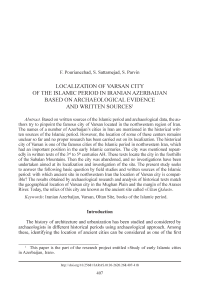Localization of Varsan city of the Islamic period in Iranian Azerbaijan based on archaeological evidence and written sources
Автор: Pourianezhad F., Sattarnejad S., Parvin S.
Журнал: Краткие сообщения Института археологии @ksia-iaran
Рубрика: Археология старого и нового света
Статья в выпуске: 268, 2022 года.
Бесплатный доступ
Based on written sources of the Islamic period and archaeological data, the authors try to pinpoint the famous city of Varsan located in the northwestern region of Iran. The names of a number of Azerbaijan's cities in Iran are mentioned in the historical written sources of the Islamic period. However, the location of some of these centers remains unclear so far and no proper research has been carried out on its localization. The historical city of Varsan is one of the famous cities of the Islamic period in northwestern Iran, which had an important position in the early Islamic centuries. The city was mentioned repeatedly in written texts of the 3rd to 5th centuries AH. These texts locate the city in the foothills of the Sabalan Mountains. Then the city was abandoned, and no investigations have been undertaken aimed at its localization and investigation of the site. The present study seeks to answer the following basic question by field studies and written sources of the Islamic period: with which ancient site in northwestern Iran the location of Varsan city is compatible? The results obtained by archaeological research and analysis of historical texts match the geographical location of Varsan city in the Mughan Plain and the margin of the Araxes River. Today, the relics of this city are known as the ancient site called «Ultan Qalasi».
Iranian azerbaijan, varsan, oltan site, books of the islamic period
Короткий адрес: https://sciup.org/143180137
IDR: 143180137 | DOI: 10.25681/IARAS.0130-2620.268.407-418
Текст научной статьи Localization of Varsan city of the Islamic period in Iranian Azerbaijan based on archaeological evidence and written sources
The history of architecture and urbanization has been studied and considered by archaeologists in different historical periods using archaeological approach. Among these, identifying the location of ancient cities can be considered as one of the first
1 This paper is the part of the research project entitled «Study of early Islamic cities in Azerbaijan, Iran».
archaeological goals ( Velayati et al. , 2015. P. 83). In the Islamic period, archaeologists use these sources in their studies due to the existence of written historical sources. In the books of the Islamic period, the names of some cities are mentioned many times and their religious, political, social, economic characteristics and even their urbanization and architecture studies are described. The study of the survived texts of historians and geographers of the early Islamic period indicates the existence of cities in the northwestern region of Iran that no longer exist today. Research on these cities by tracing the remains of historical texts, using archaeological studies and matching them with preserved ruins, can to some extent lead to the discovery of the location of these cities and provide valuable information about them ( Pakbaz et al. , 2019. P. 38; Sattarnejad et al. , 2020a).
Northwestern Iran is known in historical sources as Azerbaijan or Azarbaijan. Today, Northwestern Iran includes the provinces of East Azerbaijan, West Azerbaijan and Ardabil. This region has various monuments of the Islamic period. Many names of its cities are mentioned in historical sources. In this region, a number of cities such as Barzand ( Mostofi , 2002. P. 69), Varsan ( Abulfeda , 2006. P. 462), Bileqan ( Al-Yagoubi , 2001. P. 79), Badzhiravan ( Mostofi , 2002. P. 69), Kolsereh ( Baghdadi , 1981. P 110) existed and were destroyed for various reasons in different centuries of Islam. Today, only the names of these cities can be found in historical texts. The historical city of Varsan was located on the northeastern slopes of the Sabalan Mountains on the road connecting Ardabil to Aran province (Republic of Azerbaijan) and its cities such as Bileqan and Barda district. Varsan served as a commercial intermediary city and caravanserai in the region of Azerbaijan. This special position and location in the fertile plain made Varsan a thriving city. In this research, an attempt is made to answer the following basic questions by examining the information obtained from the written historical sources of the Islamic period and using the data provided by archaeological studies and excavations: The location of which archeological site in northwestern Iran is compatible with the remains of Varsan city? Based on the archaeological surveys carried out by the authors and its compatiblity with the written sources of the Islamic period, the location of Varsan city in the region of Iranian Azerbaijan has been determined.
Research method
The present study, using the library method, examines the texts of the 3rd to 7th centuries AH, which are considered as the first-hand sources of this research, and also is based on archaeological findings. First, the location of Varsan city was studied in geographical and historical books of the Islamic period. Then, the landmarks of the early Islamic period were identified based on archeological surveys conducted in recent years in the Mughan plain of Ardabil province. In the next stage, the location of the Varsan city was adapted to these sites proceeding from the descriptions of Islamic sources. The results of these studies lead to the identification of the exact location of the historic city of Varsan in the northwestern region of Iran along the Araxes River.
Review of the literature
So far, studies have been conducted on the localization of historical cities of the Islamic period in northwestern Iran and the Republic of Azerbaijan. The results of these researches have made it possible to identify the location of cities such as Barzand, Bileqan and Barda today. But so far no research has been performed on the location of the city of Varsan in the northwestern region of Iran. Therefore, only the sources of the Islamic period, especially the books of the 3rd to 7th centuries AH, such as « Al-Buldan » written by Al-Yaqoubi, « History of the Prophets and Kings » by Muhammad ibn Jarir al-Tabari, « Futuh al-Buldan » by Yahya al-Baladhuri, « Masalik al-Mamalik » by Istakhri, etc., referred to Varsan city. In the present research, the location of this city in Ardabil province and Mughan Plain has been studied for the first time. The results of the research are important for recognizing the location of one of the famous cities of Azerbaijan province in the Islamic period.
Varsan city in the written sources of the Islamic period
Our information about Varsan city is limited to historical sources. The geographical location of the city was mentioned in the texts of geographers and historians of the 3rd to 6th centuries AH. In these sources, the location of Varsan has been recorded in the province of Azerbaijan ( Istakhri , 1961. P. 158; Ibn Rustah , 2020. P. 271). According to these sources, the city was situated in a plain along the Araxes River ( Maqdisi , 2010. P. 559; Abu Dulaf , 1975. P. 47). Also, the location of Varsan was related with the communication road of Barzand cities to Bileqan and Barda ( Is-takhri , 1961. P. 156; Al-Yaqoubi , 2001. P. 46). In the preserved maps from the Islamic period, the location of Varsan is clearly shown. Abu Ishaq Ibrahim ibn Muhammad al-Farisi al-Istakhri, an Iranian geographer (10 AD), known as Karkhi, has drawn a map of the cities of Azerbaijan in his book named « Masalik al-Mamalik » (« Roads of the Realms »). In this map, the location of Varsan has been shown close to the Arax-es River and on the communication road from Bileqan city to Barzand (Fig. 1).
In the written sources of the Islamic period, the name of Varsan city is mentioned many times in the descriptions of the early Islamic cities. One of the oldest written sources of the Islamic period in which the name of Varsan city is mentioned is the book « al-Buldan » by Ibn al-Faqih (290 AH). He wrote: «…Varsan was a hill. Marwan ibn Muhammad ibn Marwan [one of the early rulers of Islam – authors] ordered to construct it. He built a castle for the city» ( Ibn al-Faqih , 1995. P. 126). Al-Baladhuri mentioned the existence of a historical bridge next to the city in his book «Futuh al-Buldan» : «…There was a bridge in Varsan, similar to it built in areas such as Arshaq by Babak Khorramdin [one of the Iranian military leaders – authors]. Varsan city was built by the order of Marwan, the forth Umayyad caliph. He built castles all around the city. This city later became part of the land of Ja’far’s mother, the daughter of Ja’far ibn al-Mansour» ( Al-Baladhuri , 1958. P. 462). Varsan seems to have been famous as a small town in the province of Azerbaijan after the second century AH; In the book « Masalik al-Mamalik », Istakhri wrote not once about Varsan city the same as cities such as Tabriz, Urmia, Marand, Miyaneh, etc. ( Istakhri , 1961. P. 156). The name of
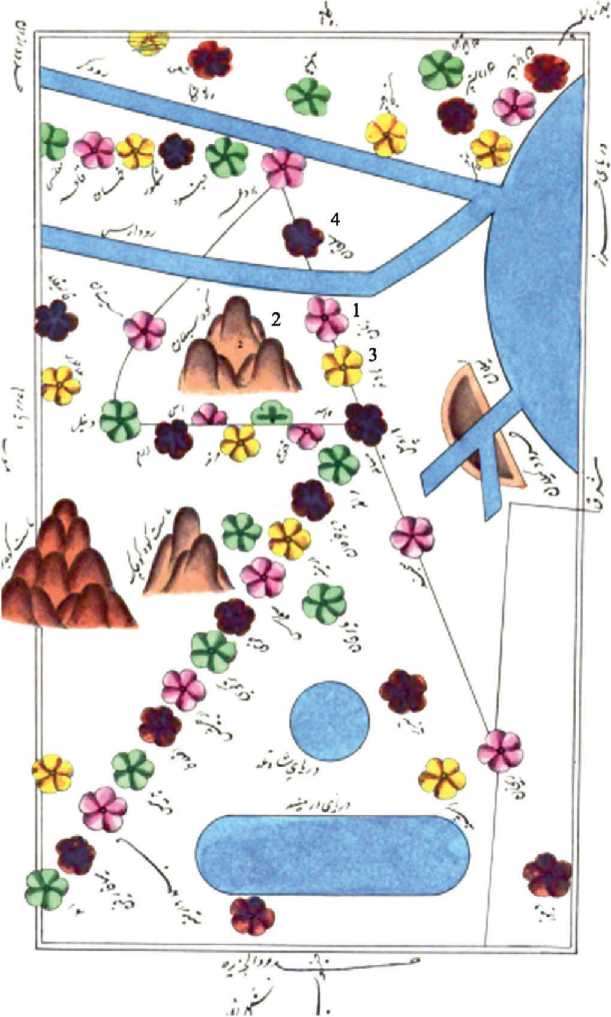
Fig. 1. Masalik al-Mamalik by Istakhri. Map
1 – Varsan; 2 – Sabalan; 3 – Barzand; 4 – Bileqan
Varsan can be found in many books of the 3rd to 6th centuries AH. In these sources, Varsan is generally introduced between the two cities of Barzand and Bileqan. For example, Al-Yaqoubi (3rd century AH) wrote in the book « al-Buldan » as follows: «…and from Barzand to the city of Varsan and from Varsan to Bileqan is a communication road…» ( Al-Yaqoubi , 2001. P. 46). What is clear in these sources is that the name of Varsan was generally mentioned due to its geographical location and its importance is mostly related with its location on the road between the cities of Azerbaijan and Aran (a region located in the Republic of Azerbaijan). The last references to Varsan are related to the 8th century AH ( Ibn Khaldun , 1987. P. 112) (Tabl. 1). After this period, the prosperity of Varsan city declined and gradually reduced.
Table 1. Name and location of Varsan city in the sources of the Islamic period (after: Sattarnejad et al ., 2020a)
|
Thewriter |
The book |
Century AH |
Written form |
Position |
|
Ahmad ibn Ishaq al-Yaqoubi |
Al-Buldan |
3 |
Varsan |
Barzand – Varsan – Bileqan |
|
Ibn Rustah |
al-A‘laq al-Nafisa |
3 |
Varsan |
Varsan – Bileqan |
|
ibn al-Faqih al-Hamadani |
Al-Buldan |
3 and 4 |
Varsan |
Azerbaijan province |
|
Al-Baladhuri |
Futuh al-Buldan |
2 and 3 |
Varsan |
Azerbaijan province |
|
Istakhri |
Al-Masalik wa-l-Mamalik |
4 |
Varsan |
Barzand – Varsan – Bileqan |
|
Abu Dulaf |
Abu Dulaf’s travel book |
4 |
Varsan |
Along the Araxes River |
|
Maqdisi |
Ahsan al-Taqasim |
4 |
Varsan |
Plain, along the Araxes River |
|
Ibn Khaldun |
Ibn Khaldun’s history |
8 |
Mughan of Azerbaijan |
The spatial site of Varsan city based on written historical sources and archaeological surveys
According to the descriptions of historical sources of the Islamic period, Varsan city is located in the Mughan Plain along the Araxes River (Istakhri, 1961. P. 158; Ibn Rustah, 2020. P. 271). Mughan Plain is situated in northwestern Iran, west of the Caspian Sea and north of Ardabil province. Most of the Mughan Plain is located in the Republic of Azerbaijan and about one third (100,000 ha) is located in Iran. In general, in terms of natural geography, this plain is considered a part of the plains and lowlands of the Caspian Sea western basin. Mughan plain is located in the east of Sabalan Mountain. In this plain, the Araxes River flows permanently and is considered one of the most important water resources in the region. Mughan Plain was the location of the Arab army during the Islamic era, especially in the early centuries of Islam. In this plain, large areas such as Ultan Qalasi, Yale Sui, Qiz Qa-lesi and Barzand are related with this period (Khancherli, 2015). Among these large sites in the Islamic period, only the Ultan Qalasi site is located exactly on the banks of the Araxes. The location of Varsan city is accurately shown close to the Araxes River on its western side in the preserved maps of geographers of the Islamic period. Also, it was mentioned near the Araxes River in the descriptions from the books of the Islamic period. Thus, Muhammad ibn Ahmad Shams al-Din al-Maqdisi, a geographer of the 4th century AH, in his book «Ahsan al-taqasim», mentioned the location of Varsan city in a plain and along the Araxes River (Maqdisi, 2010. P. 559). According to the descriptions of geographers of the Islamic period and their comparison with the Islamic period sites of Mughan plain, it is Ultan Qalasi that most likely contains the remains of Varsan city. The details of the conditions of the ancient city of Varsan mentioned in the sources, including its fortifications, the moat around it, its location near the Araxes, and its vast area, are compatible with the conditions we can see in Ultan Qalasi area.
Location of Ultan Qalasi
Oltan site is located in Mughan plain along the Araxes River (Fig. 2). Its geographical coordinates are 39°36’27.19”N and 47°45’28.16”E. This castle was built on a land with an area of 320,000 sq. m, the remains resemble a fortress. Ultan Qalasi was built in the Parthian period and its first founders were the Parthians, but its prosperity dates back to the Sassanid and early Islamic periods. Due to its strength and suitable location, it was used until the 20th century AH. During the excavation of Ul-tan Qalasi, archaeologists came across a coherent architectural remains dating from the Parthian and the Islamic periods, most of the artifacts found belong to the 3rd and 4th centuries AH, the later materials are related with the Sassanid architecture ( Alizadeh , 2011).
Various pottery of the early Islamic period of Ultan Qalasi is important and worth attention. Inside the castle, kind of hills are visible that once were small building units, the main buildings were located on the east side. Due to the change of direction of the Araxes River, part of it has been washed and destroyed, but despite this, most of it is still buried underground. Ultan Qalasi was considered a city castle due to its area of 50 ha, inside it residential spaces were situated, while industrial areas such as various workshops for metalworking, glass-making and pottery-making were placed outside the castle. A 15-meter moat was built around the city to protect the castle from enemy attacks. It was filled by two water channels launched from the Araxes River. Archaeological excavations have identified the remains of various architectural constructions that generally were built of bricks (Fig. 3).
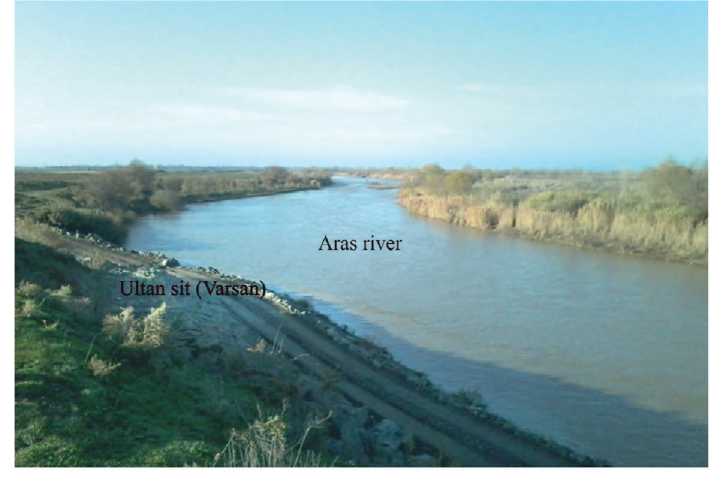
Fig. 2. Araxes River next to the site of Ultan Qalasi
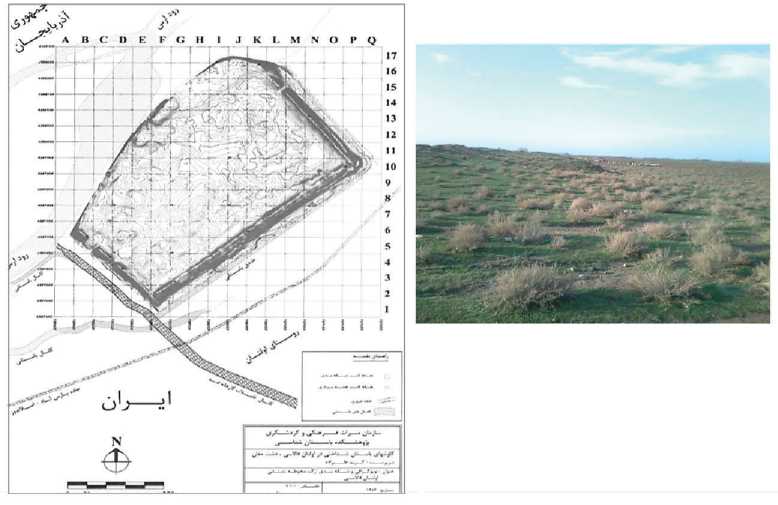
Fig. 3. The site of Ultan Qalasi. Plan and view
Pottery related to the site
While exploring different parts of Ultan Qalasi, fragments of pottery were retrieved. In terms of form, technique, designs, etc. these findings clarify the most important periods of settlement in the site. On the other hand, it should be said that most of the structures and cultural features of the site, as well as the regional and trans-regional cultural exchanges of Ultan Qalasi with other sites and areas depend on the study and focus on its pottery findings.
In general, Oltan Qalaesi’s pottery can be divided into two main groups: 1) nonglazed pottery and 2) glazed pottery (Fig. 4). These pottery groups can be compared with samples of pottery from the 6th to 13th centuries AD in the sites such as Samen in Ma-layer ( Hemmati Azandariani et al. , 2015. P. 195), Hegmatana hill ( Ranjbaran , 2012. P. 475, 493), Malin site in Bakharz County ( Khodadoost et al. , 2015. P. 163), the ancient city of Jiroft ( Chubak , 2012. P. 109, 110), Narmashir Plain in Kerman ( Amirhajlou, Saqaei , 2018. P. 212), Sang Castle in Sirjan ( Amirhajlou, Sediqian , 2019. P. 164), Barda ( Wordsworth , 2018. P. 73), Tahaq in Khomein ( Sharahi, Sediqian , 2019), Kaboud and Modavvar Tower in Maragheh ( Sattarnejad et al. , 2020b; Sattarnejad, Parvin , 2019). These pottery materials belong to the early Islamic and Seljuk eras.
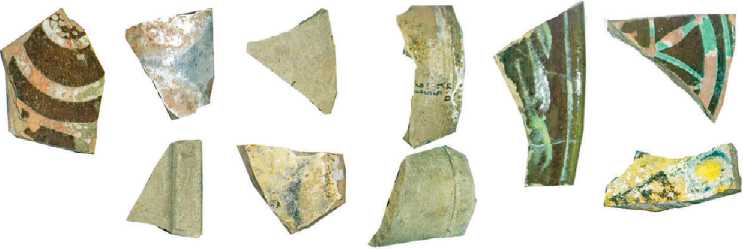
Fig. 4. The site of Varsan. Pottery of the Islamic period (after: Alizadeh , 2011)
Discussion and analysis
As mentioned, our basic information on Varsan city is related to written sources from the 8th to the 13th centuries AD. The authors of these sources placed Varsan among the cities of Azerbaijan province. The city is located between Barzand and Bileqan and is the last city in the province of Azerbaijan along the Araxes River. In order to obtain the exact location of Varsan city, its approximate location was first identified based on historical sources. Then, proceeding from archaeological evidence obtained during surface survey of the site of Ultan Qalasi, the data and their compatibility with each other were discussed and analyzed. Today, the geographical location of some of several large cities located near Varsan has been identified. The cities of Bileqan and
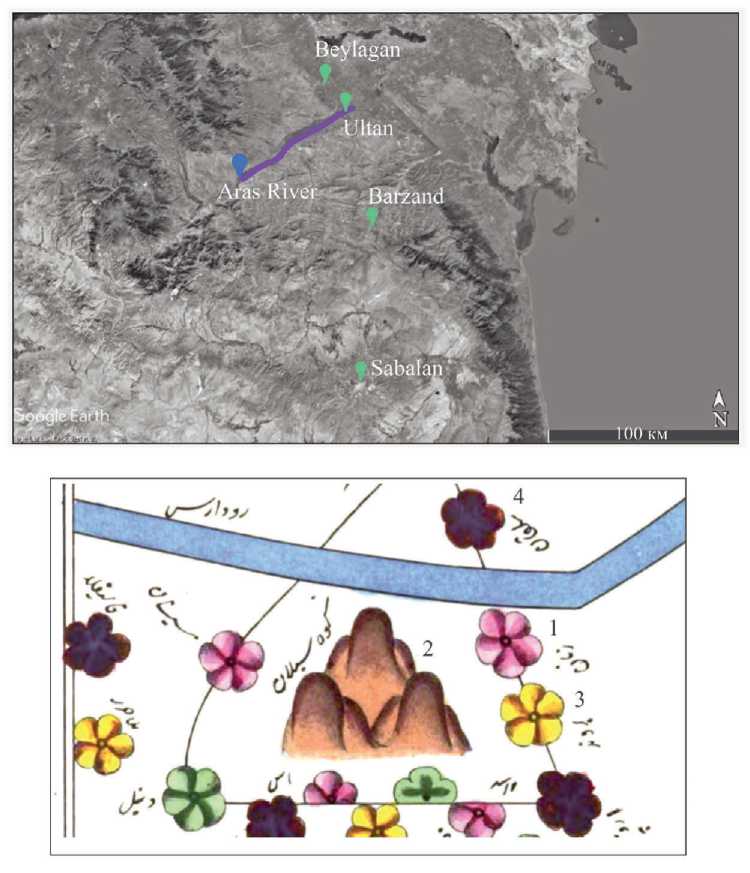
Fig. 5. The location of early Islamic cities in the map of the book of « Al-Masalik wa-l-Mamalik » by Istakhri and the aerial image of the contemporary period 1 – Varsan; 2 – Sabalan; 3 – Barzand; 4 – Bileqan
Barda were identified by archeological surveys conducted in the Republic of Azerbaijan. Today, the old site of Bileqan is located in the Republic of Azerbaijan. The city is situated 30 km north of the Ultan Qalasi site. The ruins of the city of Bajuran, near the city of Jalilabad in the east of the Moghan Plain in the Republic of Azerbaijan, have been identified and studied archaeologically. Also today, Barda in the Republic of Azerbaijan is the place of the old city of Barda, archaeological surveys have been conducted there ( Wordsworth , 2018). Barzand city in the Moghan Plain, located near Varsan, is now a small village 75 km south of the Araxes River. Between Barzand and Bileqan, only a large site called «Ultan Qalasi» of the Sassanid and early Islamic periods has been identified ( Alizadeh , 2011). This area is exactly attached to the Araxes River and is located on the communication route from Barzand to Bileqan. Matching the location of these cities in the map of the book of « Al-Masalik wa-l-Mamalik » by Istakhri (4th century AH) with the contemporary aerial map shows that the location of Varsan is compatible with the site of Ultan Qalasi (Fig. 5).
The details of Varsan mentioned in the sources, including fortifications, the moat around it, its vast area and closeness to the Araxes River, correspond to the features of Ultan Qalasi. Oltan site is situated next to the Araxes. The site is one of the largest ones of the Sassanid and early Islamic periods in the Moghan Plain. The city’s defensive tower and wall were identified and disclosed by archaeological excavations. The pottery from the surface is also of Samera style. The pottery dates back to the 3rd and 4th centuries AH. Samera style pottery was spread in the region of Azerbaijan in the sites where the headquarters of the Arab army were situated ( Khancher-li , 2015). In these cities defensive walls were built by order of the Arab rulers ( Al-Baladhuri , 1958. P. 462). Varsan city prospered during the Seljuk period. A study on the sources of the Islamic era, especially of the 7th and 8th centuries AH shows that Varsan completely lost its prosperity during the Ilkhanid period. Writers of the Ilkha-nid period such as Hamdallah Mustawfi, in the book « Nuzhat al-qulub », while referring to the Bileqan city in Azerbaijan and Aran, do not mention Varsan ( Mostofi , 2002. P. 104, 105). Qazvini, the historian of the Ilkhanid period, mentions the cities of Bar-da, Bileqan and Mughan in his book « Asar al-Bilad Akhbar al-Ibad ». But he does not mention Varsan ( Qazvini , 1995. P. 654–668). Like famous cities of early Islam such as Barzand, Koreh Sar (Koleh Sar), Bajruvan and Yale Sui ( Tahmasebi , 2019), Varsan lost its position after the Seljuk period and over time was gradually destroyed by human and natural factors. Only the village named Oltan still exists.
Conclusions
According to our studies results, Varsan was one of the cities of Azerbaijan province. It prospered between the 3rd and 7th centuries AH due to its location on the trade route and caravanserai of the cities of Barzand to Bileqan. In general, in the surviving texts of historians and geographers of the early Islamic centuries, Varsan city was located in the foothills of the Sabalan Mountains and the communication route from Azerbaijan to Aran in the Mughan Plain and along a river. A comparative study of the descriptions of written sources of the Islamic period with the landmarks of the early Islamic period of the Mughan Plain, especially near the Araxes River, has shown that the site of Ultan Qalasi most corresponds to the remains of Varsan city. This site is related with the Araxes and located on the communication route from Bar-zand to Bileqan. Evidence of the city’s defensive tower and wall were discovered and investigated during archaeological excavations. Summing up, after matching the descriptions of historical sources and archaeological data obtained from the surface of Ultan Qalasi, this site should be considered as the ground for the hypothesis of localizing the site of Varsan city of the Islamic era, which can be seen today as a large area along the Araxes River.
Список литературы Localization of Varsan city of the Islamic period in Iranian Azerbaijan based on archaeological evidence and written sources
- Abu Dulaf, 1975. Abu Dulaf travel book in Iran. Tehran: Zav’ar Publications.
- Abulfeda I., 2006. Taqwim al-Buldan. Cairo: Al-Thaqafa Al-Diniya Publications.
- Al-Baladhuri A., 1958. Futuh al-Buldan / Transl. by M. Tavakol. Tehran: Noqreh.
- Alizadeh K., 2011. Ultan Qalasi: A Fortified Site in the Sasanian Borderlands (Mughan Steppe, Iranian Azerbaijan) // Iran. Vol. 49. No. 1. P. 55–77.
- Al-Yaqoubi A., 2001. Al-Buldan. Beirut: Dar Al-Kitab Al-Almiyeh Publications.
- Amirhajlou S., Saqaei S., 2018. Distribution, Continuity and Diversity of Islamic Ceramics in the Settlements of Narmashir Plain, Kerman // Pazhoheshha-ye Bastan shenasi Iran. No. 8 (19). P. 207–226.
- Amirhajlou S., Sediqian H., 2019. Archaeological Research on Islamic Pottery from Qal´eh Sang, Old Sirjan (Kerman Province, Iran) // Pazhoheshha-ye Bastan shenasi Iran. No. 10 (25). P. 155–180.
- Baghdadi Q., 1981. Masalak and Malikas. Beirut: Dar al-sader.
- Chubak H., 2012. Report of Islamic Pottery, Povinik Castle. Tehran: Cultural Heritage Organization. Hemmati Azandariani E., Khaksar A., Shabani A., 2015. Studying and Analyzing the Islamic Potteries from Underground Troglodytic Architecture Complex at Samen, Malayer // Archaeological Research. No. 13. P. 189–206.
- Ibn al-Faqih A., 1995. Short translation of Al-Buldan. Tehran: Cultural Foundation.
- Ibn Khaldun A., 1987. Ibn Khaldun’s history. Vol. 3. Lebanon. Beirut: Dar al-Fikr Publications.
- Ibn Rustah A., 2020. Al-A‘laq al-Nafisa. Beirut: Dar Sader.
- Istakhri I., 1961. Al-Masalik wa-l-Mamalik, by Iraj Afshar. Tehran: Book Translation Publishing House.
- Khancherli M., 2015. Study of pottery of the first centuries of Islam in Ardabil province: M. A. Thesis in Archeology, Mohaghegh Ardabili University.
- Khodadoost J., Mousavi Haji S., Taghavi A., Pooraliyari S., 2015. An Analytical Study of the Pottery at the Malin Site (Bakharz) // Pazhoheshha-ye Bastan shenasi Iran. No. 7 (13). P. 157–172.
- Maqdisi A., 2010. Ahsan al-Taqasim fi al-Marafa al-Aqalim. Beirut: Dar al-Asaq.
- Mostofi H., 2002. Nuzhat al-Qulob, edited by Muhammad Dabir Siagi. Qazvin: Hadith Imroz Publications. Pakbaz D., Neyestani J., Karimian H., 2019. Localization of Ziz city based on historical sources and archaeological surveys // Journal of Archaeological Studies. Vol. 11. No. 2. P. 7–56.
- Qazvini Z., 1995. Asar al-Bilad Akhbar al-Ibad. Tehran: Amirkabir Publications.
- Ranjbaran M.R., 2012. Final report of the first and second chapters of the archaeological exploration of Hagmatana hill, Hamadan province // Cultural heritage.
- Sattarnejad S., Parvin S., 2019. Manifestation of Islamic Decorative Arts in the Architecture of Gonbad- e-Kabood and Gonbad-e-Ghaffariyeh // ANASTASIS. Research in Medieval Culture and Art. Vol. VI. No. 2. P. 1–18.
- Sattarnejad S., Parvin S., Hendiani E., 2020a. Chronology of the historical context of Maragheh City based on archaeological exploration and historical written sources // КСИА. Вып. 260. P. 397–406.
- Sattarnejad S., Parvin S., Hendiani E., 2020b. The symbology of swastika in the Gonbad-e-Sorkh Tomb // Codrul Cosminului. Vol. 26 (1). P. 7–18.
- Sharahi E., Sediqian H., 2019. Archaeological study of medieval Islamic pottery in the underground part of Tahiq Khomeini // Archaeological Studies of Parseh No. 8. P. 151–148.
- Tahmasebi F., 2019. Report of the first season of archaeological excavations of Yale Sui site // Cultural Heritage Research Institute.
- Velayati R., Mehdizadeh B., Khanali H., 2015. Location of Ojan Ilkhanid City Based on Historical Resources and Archaeological Investigations (Research on Sites of Koller and Dali Darasi in Bostan Abad City) // Bagh-e Nazar. No. 12 (34). P. 83–92.
- Wordsworth P., 2018. Problematising the shifting capitals of Medieval Arran: From Bardhaʿa to Janza in the 10th–12th centuries // Iran. Vol. 56. No. 1. P. 64–76.

